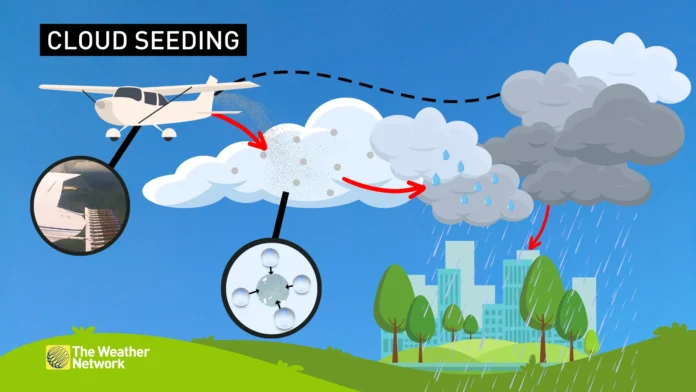“Artificial rain” commonly refers to the process of cloud seeding.
Cloud seeding is an artificial modification in weather that leads to precipitation in clouds. This precipitation will lead to rainfall and snowfall in areas suffering from drought or water sarcasm.
Cloud seeding does not guarantee a definite response, as its success depends on atmospheric conditions, cloud composition, and geographical location.
How Does It Occur?
Well, all the process revolve around precipitation-How humans provoke precipitation in clouds, leading to rain or snow formation. Following the step-by-step process will help you have a better understanding of the topic:
1. Introduction to Seeding Agents:
The cloud modification process process requires the introduction of seeding agents that act as nuclei for water droplets in the clouds. The nuclei serve as the agents on which water droplets can condense and form precipitates. The seeding agents can include substances like silver iodide, potassium iodide, or liquid propane.
2. Formation Of Ice Crystals:
Are you wondering why water retains its liquid form in clouds even at high altitudes?
The reason lies in the supercold state of water droplets. In many clouds, especially those at high altitudes where temperatures are below freezing, water droplets may remain supercooled, meaning they remain in liquid form despite being below the freezing point.
Here, the seeding agents serve as saviors; they rovide surfaces on which supercooled water droplets can condense and form ice crystals.
3. Growth of Ice Crystals:
Once ice crystals form around seeding agents, they will start attracting more supercooled water from the cloud. Thus, more condensation of water droplets on these oce crystals results in an increase in size. This process is called the Bergeron process, where supercooled water readily condenses into ice crystals, causing them to increase in size.
4. Precipitation:
Why the growth of crystal matter in cloud seeding?
The question may arise in your mind after reading the above paragraph.
An ice crystal cannot escape from the cloud without having a certain weight or density. As size of crystals increases, it becomes more heavy. Until the point arrives where it leaves the cloud by overcoming the upward air current, At this point, the ice crystals reach the earth in the form of precipita, i.e., raindrops or snowfall.
5. Enhanced Precipitation:
Cloud seeding is not a temporary process. By providing additional nuclei for the condensation and freezing of water vapor, it can potentially enhance the natural process of precipitation formation within clouds. This can lead to increased rainfall or snowfall in targeted areas, helping to alleviate drought conditions or replenish water resources.
Methods of Cloud Seeding
Cloud seeding began with the addition of seeding agents in the clouds. But how do these seeding agents reach the cloud? There are two potential methods used for this process.
1. Aircraft Dispersion
In this method, an aircraft filled with seeding agents has been flown over the cloud to initiate the process of cloud seeding. Here are some merits and demerits of this process:
Merits:
- Targeted Approach: An effort with zero output can be avoided in the air-craft dispersion method. Pilots have a choice to target only those clouds that have the potential to carry out the process of cloud seeding, resulting in a more effective response.
- Flexibility: Aircraft dispersion has no geographical restrictions. It can work at large, providing flexibility in choosing when and where to conduct cloud seeding operations.
- Rapid Deployment: Aircraft can work to control an emerging emergency condition, as they can be deployed anytime and anywhere to conduct the cloud seeding process.
Demerits:
- High Cost: Many organizations skip this method because of its expenses. The high fuel cost, timely aircraft maintenance, and pilot fee make it a less common option in financially challenged organizations.
- Weather Dependency: This process is weather-dependent. Wind seep, visibility, humidity in the air, and turbulence will decide whether to use this method or not.
- Limited Duration: Cloud seeding by aircraft cannot last longer because of the need to refill the plane full tank again. It restricts the duration of cloud seeding operations, potentially limiting their impact on precipitation.
2. Ground-Based Dispersion Method:
In the ground-base dispersion method, seeding agents are dispersed in the air of the designated area. Then the air currents are responsible for carrying them upward toward the cloud to carry out the cloud seeding process.
Merits:
- Cost-Effectiveness: The Ground-Based Dispersion Method involves using less expensive resources, such as avoiding fuel consumption and eliminating expenses for planes and pilots, thus making it more affordable for various companies.
- Continuous Operation: One can conduct ground-based dispersion without any disruption for a longer period of time. It proves effective in some conditions where inducing cloud formation requires a prolonged addition of seeding agents.
- Safety: Zero safety concerns arise since no aircraft operate in harsh weather conditions. All tasks can be performed at ground level.
Demerits:
- Limited Reach: Ground-based generators are dependent on win current for the conduction of seeding agents towards the cloud. This limitation may restrict their effectiveness in reaching distant or high-altitude cloud systems.
- Geographical Constraints: Ground-based generators are stationary and thus confined to specific locations. This may limit their utility in regions with rugged terrain or limited access to suitable sites for installation.
- Dependency on Wind Patterns: A slight change in wind patterns is potent enough to ruins the whole effort as it depends on wind for its dispersion.
Conclusion
Cloud seeding is a vivid example of man-advanced technology. But its environmental impact, ethical considerations, and uncertain effectiveness still make it a questionable process in the eyes of many people, so deep research and thorough consideration are necessary to carry out this process.
Read More: The Power of Storytelling in Marketing: Why is it important for Business Success?


